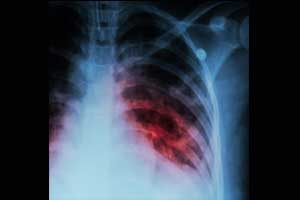- Home
- Editorial
- News
- Practice Guidelines
- Anesthesiology Guidelines
- Cancer Guidelines
- Cardiac Sciences Guidelines
- Critical Care Guidelines
- Dentistry Guidelines
- Dermatology Guidelines
- Diabetes and Endo Guidelines
- Diagnostics Guidelines
- ENT Guidelines
- Featured Practice Guidelines
- Gastroenterology Guidelines
- Geriatrics Guidelines
- Medicine Guidelines
- Nephrology Guidelines
- Neurosciences Guidelines
- Obs and Gynae Guidelines
- Ophthalmology Guidelines
- Orthopaedics Guidelines
- Paediatrics Guidelines
- Psychiatry Guidelines
- Pulmonology Guidelines
- Radiology Guidelines
- Surgery Guidelines
- Urology Guidelines
AIIMS researchers develop highly sensitive test for TB

A team of researchers from the All India Institutes of Medical Sciences (AIIMS), New Delhi, have developed a highly sensitive diagnostic test for pulmonary tuberculosis and pleural TB. The diagnostic test makes use of a DNA aptamer (a small single-stranded DNA molecule that binds to a specific target molecule) that shows high binding affinity to a TB antigen.
Sensitivity for pulmonary tuberculosis and pleural tuberculosis were 94% and 93%, respectively, and specificity was 100% for pulmonary tuberculosis and 98% for pleural tuberculosis.
The results were published in the journals Analytical Biochemistry and ACS Infectious Diseases.
Sputum samples were used for diagnosing pulmonary tuberculosis while pleural fluid was used for diagnosing pleural tuberculosis.
The laboratory-based aptamer test for diagnosing pulmonary TB takes about five hours to turn in the results while the portable, rapid test takes just 30 minutes. “The lab-based test has several steps and so takes time while the rapid test is an electrochemical sensor-based detection which is a direct detection and so takes less time,” says Surabhi Lavania, Department of Biotechnology, All India Institute of Medical Sciences. At 92.3% and 91.2%, the sensitivity and specificity of the portable test are a bit inferior compared with the lab-based test.
In the case of pleural TB, the aptamer-based lab diagnosis was far superior to even Xpert. While the sensitivity was about 22% with Xpert, it was about 93% with aptamer. “Xpert relies on the presence of bacteria, which is nearly absent in pleural fluid, while the aptamer-based testing relies on bacterial antigen and so has high sensitivity,” says Pooja Kumari from AIIMS and first author of the paper on pleural TB test.
The sensitivity of the lab-based and portable aptamer-based test for pulmonary TB is far superior compared with smear microscopy, X-ray and even ELISA.
Portable and Cost-Effective Test
“The portable test is cheaper and can be used for screening pulmonary TB and active case finding in high-risk groups,” says Professor Jaya Sivaswami Tyagi from AIIMS.
The HspX antigen present in sputum samples of people with pulmonary TB is made use of for the diagnosis. The team had used the same antigen present in the cerebrospinal fluid samples for diagnosing TB meningitis. The researchers made use of a particular aptamer (H63SL2-M6) that detects the antigen in sputum samples for pulmonary TB diagnosis.
“Sputum is a difficult sample to handle due to the presence of mucus. The sputum should first be made into a uniform suspension before applying the test. So [we] must prepare the sample and this takes time,” says Prof. Tyagi.
In the case of the lab-based diagnosis, the sputum sample is immobilized on a plate and the aptamer is added. If the sample is positive for pulmonary TB then it will contain the HspX antigen and the aptamer binds to it. An enzyme (horseradish peroxidise) that binds to the aptamer (through biotin-streptavidin affinity) is then added followed by a substrate. A change in substrate color is seen indicating that the sample is positive for pulmonary TB. If the sample is negative for pulmonary TB, then even the first step of the aptamer binding to the sample does not take place and the color change does not occur.
Relying on HspX antigen to diagnose pleural TB in a lab setting was found to be effective and highly sensitive (93%).
Rapid diagnosis
To make the pulmonary TB diagnosis portable, the researchers bound the aptamer to an electrode coated with gold nanoparticles. “When the sample containing the HspX antigen is added, the aptamer binds to the antigen and undergoes a structural change, which is read out in the electrical signal,” says Dr. Tarun Kumar Sharma from Translational Health Science and Technology Institute (THSTI), Faridabad, and the other corresponding author of the papers. “There is a drop in electrical signal if the sample is positive and no change in signal when the sample is negative.”
The electrode is already immobilized with the aptamer, so only the liquefied sputum has to be added and the reaction is instantaneous. “Most time is taken to liquefy the sputum sample than the testing per se,” says Prof. Tyagi. No sample processing is needed in the case of pleural TB samples.
“We are also trying to adapt this aptamer on an electrode for rapid diagnosis of pleural TB,” says Dr. Sharma.
“We have applied for a patent for the aptamer reagent and have licensed it to AptaBharat Innovation Pvt. Ltd, a start-up at THSTI. We soon plan to validate the tests on well-characterized panel of specimens and field evaluation,” says Prof. Tyagi.
For further reference follow the links: https://doi.org/10.1016/j.ab.2018.10.019 and 10.1021/acsinfecdis.8b00201

Disclaimer: This site is primarily intended for healthcare professionals. Any content/information on this website does not replace the advice of medical and/or health professionals and should not be construed as medical/diagnostic advice/endorsement or prescription. Use of this site is subject to our terms of use, privacy policy, advertisement policy. © 2020 Minerva Medical Treatment Pvt Ltd